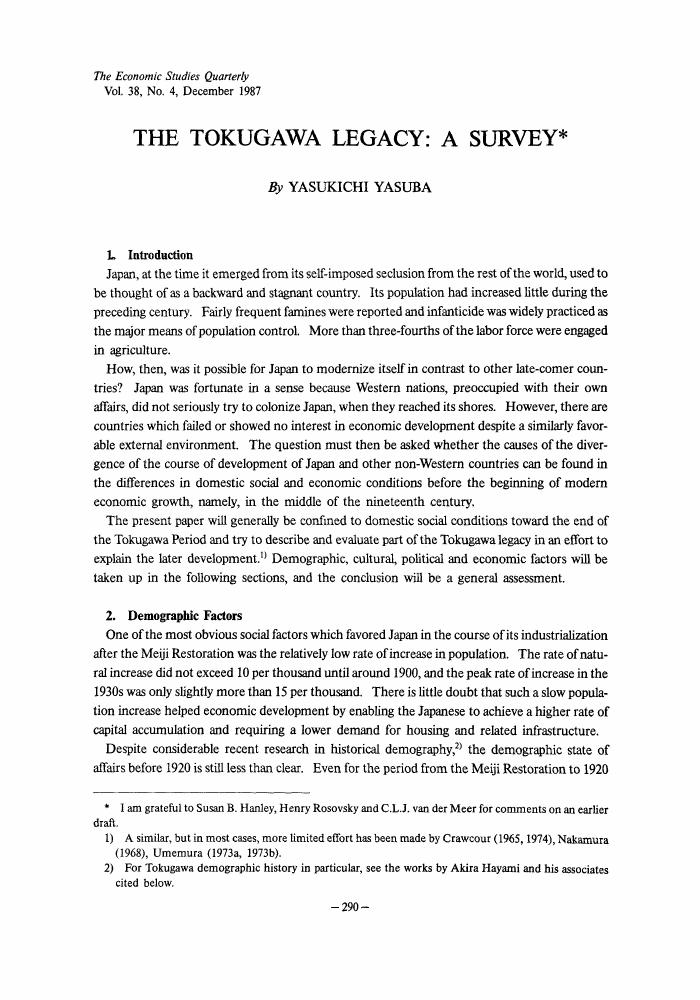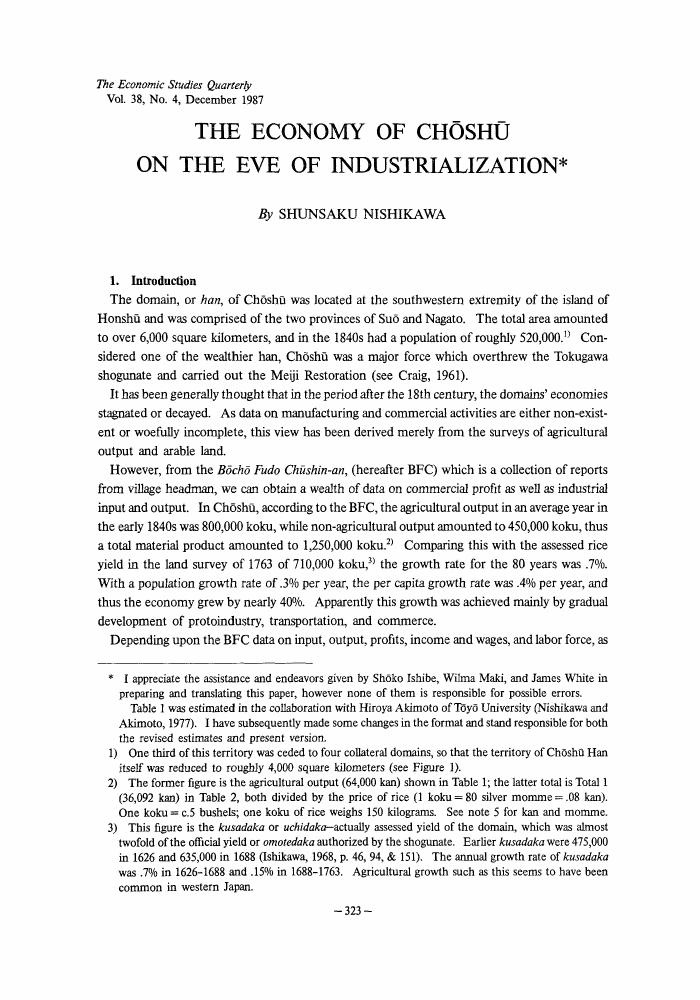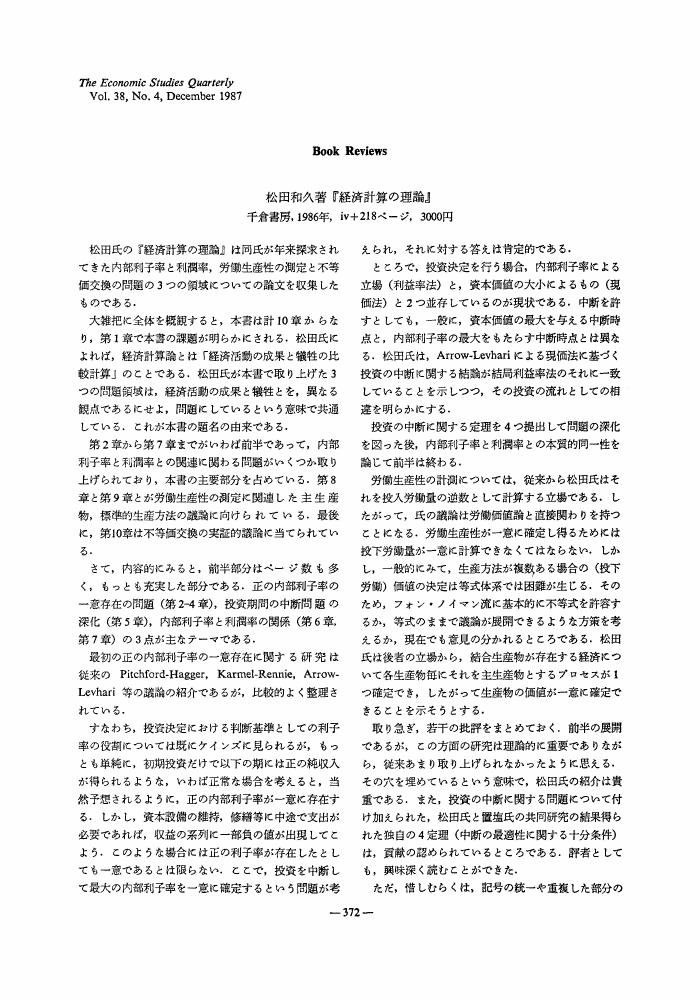1 0 0 0 OA GROWTH POTENTIAL IN A NONCAPITALIST ECONOMY
- 著者
- TOYOAKI WASHIDA
- 出版者
- JAPANESE ECONOMIC ASSOCIATION
- 雑誌
- The Economic Studies Quarterly (ISSN:0557109X)
- 巻号頁・発行日
- vol.39, no.1, pp.77-86, 1988-03-20 (Released:2007-10-19)
- 参考文献数
- 16
1 0 0 0 OA DID THE GASOLINE PRICE INCREASES CHANGE CONSUMER EVALUATIONS OF CARS IN JAPAN DURING 1970-83?
- 著者
- MAKOTO OHTA
- 出版者
- JAPANESE ECONOMIC ASSOCIATION
- 雑誌
- The Economic Studies Quarterly (ISSN:0557109X)
- 巻号頁・発行日
- vol.39, no.1, pp.87-92, 1988-03-20 (Released:2007-10-19)
- 参考文献数
- 5
- 著者
- ISAO OHASHI
- 出版者
- JAPANESE ECONOMIC ASSOCIATION
- 雑誌
- The Economic Studies Quarterly (ISSN:0557109X)
- 巻号頁・発行日
- vol.39, no.2, pp.97-117, 1988-06-20 (Released:2007-10-19)
- 参考文献数
- 43
The present paper has developed a two-period model of specific human capital incorporating the decision of the firm on the amount of investment in on-the-job training, and analyzed the effects of the specificity of the skill, formal schooling and unions on the wage and the quit rate by operating compartive statics. This attempt is valuable particularly in discussing the problem of why earnings and quits differ among workers and industries, since the amount of investment in on-the-job training is a key factor in the wage determination.One of the main conclusions is that an increase in the specificity of the skill leads to an increase in the wage rate of skilled workers because it incites the firm to invest more in them through reducing their quit possibility. The effects of formal schooling on the wage and the quit rate depend on how it affects both the efficiency of on-the-job training and the difference in productivity between the present and the alternative employment. For, if the productivity increase is sufficiently larger in the alternative employment than in the present, then the firm will refrain form investing in highly educated workers.We have tested the implications of our model by estimating it in the structural form, using the procedures of OLS and INST, and by computing White's statistic as well as t-ratio. In so doing, the bonus-earnings ratio and firm size were used as a proxy for the amount of specific training.One result of the analysis is that, as our model has described, the strong interaction between wages and quits plays a crucial role in the determination of earnings in the Japanese labor market, which is often characterized by the“rigid”institutions, such as the nenko-wage and the lifetime employment system. It is also interesting that both the firm-scale dummies and the bonusearnings ratio are significantly influential in the quit equations while not in the wage equations. This supports one of the important implications of our model that the specificity of the skill does not affect earnings directly, but indirectly through changing the quit possibility of skilled workers.
1 0 0 0 OA 中込正樹著「不均衡理論と経済政策」創文社,1985年,xii+172ページ,3500円
- 著者
- 伊藤 隆敏
- 出版者
- 日本経済学会
- 雑誌
- The Economic Studies Quarterly (ISSN:0557109X)
- 巻号頁・発行日
- vol.38, no.3, pp.281-283, 1987-09-30 (Released:2008-02-28)
1 0 0 0 OA Takeshi Amemiya, ADVANCED ECONOMETRICS Cambridge: Harvard University Press, 1985, pp. 521, $39.50
- 著者
- 森棟 公夫
- 出版者
- JAPANESE ECONOMIC ASSOCIATION
- 雑誌
- The Economic Studies Quarterly (ISSN:0557109X)
- 巻号頁・発行日
- vol.38, no.3, pp.283-285, 1987-09-30 (Released:2008-02-28)
- 参考文献数
- 2
1 0 0 0 OA THE TOKUGAWA LEGACY: A SURVEY
- 著者
- YASUKICHI YASUBA
- 出版者
- JAPANESE ECONOMIC ASSOCIATION
- 雑誌
- The Economic Studies Quarterly (ISSN:0557109X)
- 巻号頁・発行日
- vol.38, no.4, pp.290-308, 1987-12-20 (Released:2008-02-28)
- 参考文献数
- 92
- 著者
- SUSAN B. HANLEY
- 出版者
- JAPANESE ECONOMIC ASSOCIATION
- 雑誌
- The Economic Studies Quarterly (ISSN:0557109X)
- 巻号頁・発行日
- vol.38, no.4, pp.309-322, 1987-12-20 (Released:2008-02-28)
- 参考文献数
- 34
- 著者
- SHUNSAKU NISHIKAWA
- 出版者
- JAPANESE ECONOMIC ASSOCIATION
- 雑誌
- The Economic Studies Quarterly (ISSN:0557109X)
- 巻号頁・発行日
- vol.38, no.4, pp.323-337, 1987-12-20 (Released:2008-02-28)
- 参考文献数
- 17
1 0 0 0 OA THE IMPACT OF THE OPENING OF THE PORTS ON DOMESTIC JAPANESE INDUSTRY: THE CASE OF SILK AND COTTON
- 著者
- SHINYA SUGIYAMA
- 出版者
- JAPANESE ECONOMIC ASSOCIATION
- 雑誌
- The Economic Studies Quarterly (ISSN:0557109X)
- 巻号頁・発行日
- vol.38, no.4, pp.338-353, 1987-12-20 (Released:2008-02-28)
- 参考文献数
- 29
1 0 0 0 OA 松田和久著「経済計算の理論」千倉書房,1986年,iv+218ページ,3000円
- 著者
- 藤森 頼明
- 出版者
- 日本経済学会
- 雑誌
- The Economic Studies Quarterly (ISSN:0557109X)
- 巻号頁・発行日
- vol.38, no.4, pp.372-373, 1987-12-20 (Released:2008-02-28)
1 0 0 0 OA 銀行•顧客関係と企業成長
- 著者
- 今 喜典
- 出版者
- 日本経済学会
- 雑誌
- The Economic Studies Quarterly (ISSN:0557109X)
- 巻号頁・発行日
- vol.38, no.3, pp.223-233, 1987-09-30 (Released:2008-02-28)
- 参考文献数
- 17
This paper examines the effects of the bank-customer relationship in a corporate growth model with imperfect capital market. Repeated transactions under the customer relationship in the bank loan market are mainly caused by the efficient use of the information accumulated during their past transactions when the bank evaluates the firm's credit worthiness. Advantages from this inside information, however, would be deminishing as this firm grows since the corporate growth itself reveals publicly the credit worthiness of the firm.Introducing these two factors into a corporate growth model, and formulating the bank-customer relationship as a long term contract, we determine endogenously the length of the contract, the corporate growth rate, and the interest rate under the contract. Our main conclusions are that, compared with the non-repeated transactions, (1) the loan interest rate is lower under the customer relationship, and (2) the corporate growth rate decrease (increase) under the customer relationship if the firm size is large (small) at the beginning of the contract.
1 0 0 0 OA 中間目標政策と金融構造
- 著者
- 北川 雅章
- 出版者
- 日本経済学会
- 雑誌
- The Economic Studies Quarterly (ISSN:0557109X)
- 巻号頁・発行日
- vol.38, no.3, pp.234-244, 1987-09-30 (Released:2008-02-28)
- 参考文献数
- 9
This paper puts an important strand to the discussion on the intermediate target policy for income stabilization. We explicitly introduce distinction between money supply (MS) and high-poweredmoney (HPM), a la Horiuchi (1980).MS is used as an intermediate target variable, which implies the level of fund available in the financial market is fixed. In such a case, any real disturbance affects the equilibrium condition of the financial market, because amount of loans cannot respond to the borrower's demand. If, on the other hand, HPM is used, the equilibrium condition of the financial market is independent from the real disturbance.Horiuchi proposes to use HPM as an intermediate target variable if the IS disturbance is dominant. However, we revise his conclusion, because MS rule adds another stabilizing effect through interest change due to LM shift. Our conclusion is derived by making an explicit role of lenders and borrowers in the financial market, a la Modigliani and Papademos (1980), which was not explained in Horiuchi.
1 0 0 0 OA 失業と雇用保険制度
- 著者
- 大竹 文雄
- 出版者
- 日本経済学会
- 雑誌
- The Economic Studies Quarterly (ISSN:0557109X)
- 巻号頁・発行日
- vol.38, no.3, pp.245-257, 1987-09-30 (Released:2008-02-28)
- 参考文献数
- 17
It is often asserted that the introduction of the new Employment Insurance System (EIS) in 1975 was the main cause of the notable increase in the rate of unemployment after the first oil shock in Japan. In this paper we analyze the causal relationship between the revision of the EIS and unemploy ment behavior by using gross flow data of labor force insured by the old and new insurance schemes. We find that the global effect of the revision on the unemployment rate is relatively small, as compared with the effect of sectoral shifts and the aging of the labor force.
- 著者
- JUN TSUKAMOTO
- 出版者
- JAPANESE ECONOMIC ASSOCIATION
- 雑誌
- The Economic Studies Quarterly (ISSN:0557109X)
- 巻号頁・発行日
- vol.38, no.3, pp.258-263, 1987-09-30 (Released:2008-02-28)
- 参考文献数
- 12
- 著者
- MAKOTO OHTA
- 出版者
- JAPANESE ECONOMIC ASSOCIATION
- 雑誌
- The Economic Studies Quarterly (ISSN:0557109X)
- 巻号頁・発行日
- vol.38, no.3, pp.264-274, 1987-09-30 (Released:2008-02-28)
- 参考文献数
- 10
1 0 0 0 OA 丸山義浩著「企業•家計複合体の理論」創文社,1984年,vi+218ページ,3500円
- 著者
- 小尾 恵一郎
- 出版者
- 日本経済学会
- 雑誌
- The Economic Studies Quarterly (ISSN:0557109X)
- 巻号頁・発行日
- vol.38, no.3, pp.275-276, 1987-09-30 (Released:2008-02-28)
- 著者
- 金子 隆
- 出版者
- 日本経済学会
- 雑誌
- The Economic Studies Quarterly (ISSN:0557109X)
- 巻号頁・発行日
- vol.38, no.3, pp.276-278, 1987-09-30 (Released:2008-02-28)
1 0 0 0 OA 宮尾尊弘著「現代都市経済学」日本評論社,1985年,xiv+228ページ,2800円
- 著者
- 岸本 哲也
- 出版者
- 日本経済学会
- 雑誌
- The Economic Studies Quarterly (ISSN:0557109X)
- 巻号頁・発行日
- vol.38, no.3, pp.279-280, 1987-09-30 (Released:2008-02-28)
- 著者
- 辻村 和佑
- 出版者
- 日本経済学会
- 雑誌
- The Economic Studies Quarterly (ISSN:0557109X)
- 巻号頁・発行日
- vol.38, no.3, pp.280-281, 1987-09-30 (Released:2008-02-28)
1 0 0 0 OA ON HAUSMAN'S SPECIFICATION TEST
- 著者
- YUZO HONDA
- 出版者
- JAPANESE ECONOMIC ASSOCIATION
- 雑誌
- The Economic Studies Quarterly (ISSN:0557109X)
- 巻号頁・発行日
- vol.38, no.2, pp.172-183, 1987-06-20 (Released:2008-02-28)
- 参考文献数
- 29















